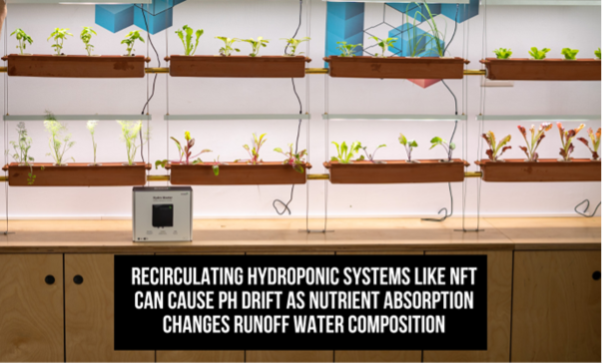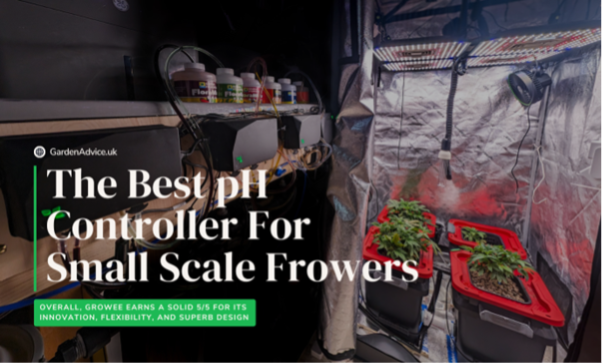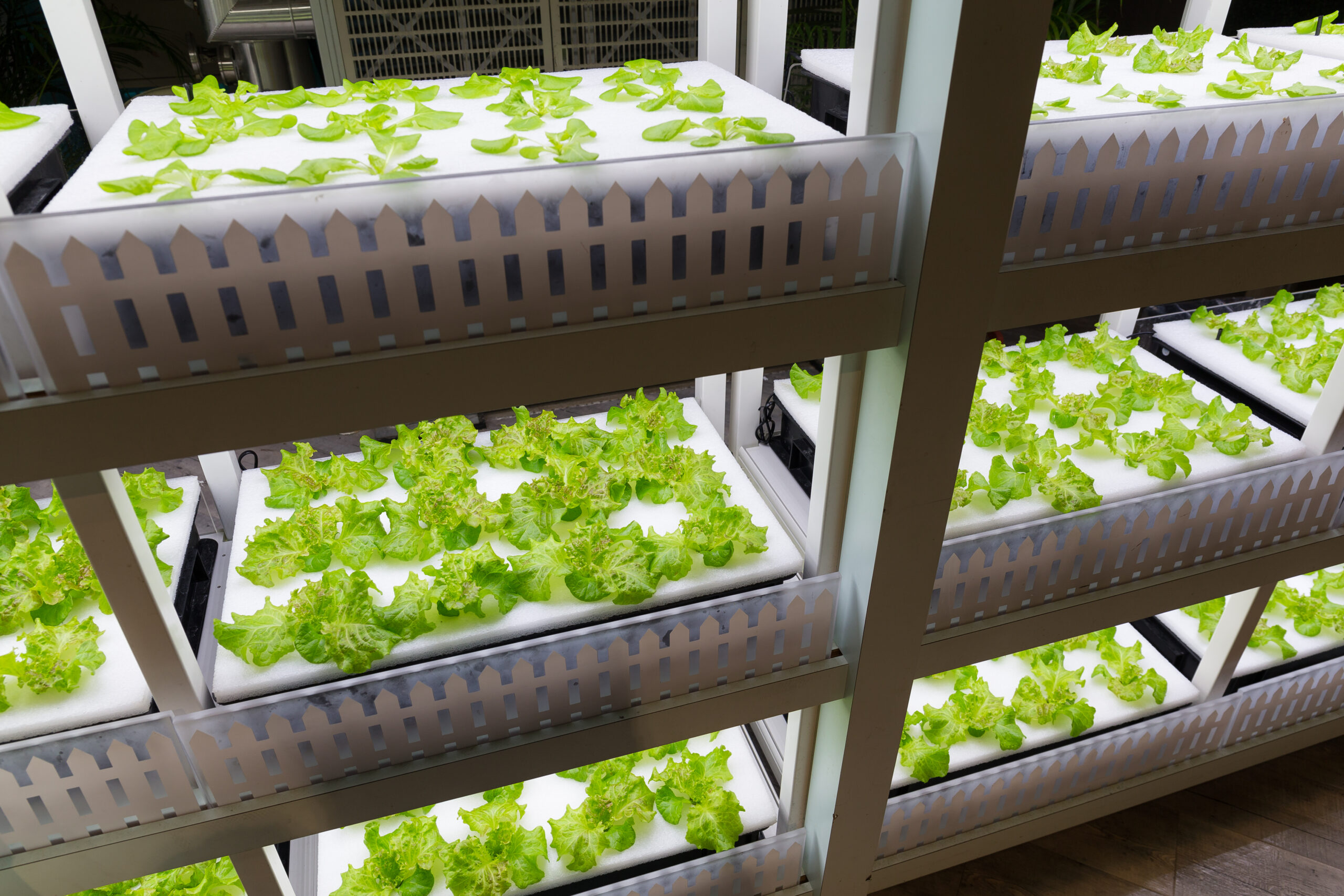Maintaining the correct pH level in your hydroponic system is critical to plant health and growth. One of the common challenges growers face is pH fluctuations. This article explains what pH drift is, why it occurs, and how it affects your hydroponic system. We will also discuss solutions to alleviate this issue and how they work.
What is pH drift?
pH drift is when the pH level of the nutrient solution you use to feed your plants changes over time, usually within a few hours.
This is common in recirculating hydroponic systems such as DWC, NFT, Ebb and Flow, RDWC, and similar systems.
pH drift can occur in two ways. That is, the pH can rise (for example, from 6.0 to 7.0) or fall (for example, from 6.0 to 5.0) over a short period of time. In some cases, the pH can even fluctuate up and down over short periods of time, especially in the absence of a pH controller.
This makes it difficult for plants to absorb the nutrients they need.
Why does pH drift occur?
Several factors contribute to pH drift in hydroponic systems.
Nutrient depletion: As plants absorb nutrients, the composition of the nutrient solution changes and the pH level can fluctuate. Water replacement: In systems where large amounts of water are frequently added for replenishment, the new water can cause the pH to change over time. Microbial activity: Beneficial and harmful microorganisms in the nutrient solution can produce byproducts that affect pH.
How does using RO water in a hydroponic system affect pH drift?
Using reverse osmosis (RO) water in a hydroponic system can affect pH drift, as RO water lacks minerals that help stabilize pH levels. In regular water, minerals such as bicarbonate act as buffers, preventing rapid changes in pH.
However, RO water is filtered to remove minerals and contains no buffers, making the pH more susceptible to fluctuations when nutrients are added. This can cause the pH to fluctuate over time, which can stress your plants. To prevent this, growers can mix a small amount of regular water with RO water. This step keeps the pH stable and ensures healthy plant growth.
Does the type of hydroponic cultivation method affect pH drift?
Yes, the type of hydroponic method can affect pH drift. In a recirculating system, water is in constant contact with the plant roots and growing medium.
As plants absorb nutrients, the chemical composition of runoff water changes. When this altered water returns to the main reservoir, it can change the pH of the entire system. This makes pH control more difficult.
The most common recirculating hydroponic systems include deep water culture (DWC), nutrient film technology (NFT), recirculating deep water culture (RDWC), and Ebb and Flow systems.

If I use a float valve on top off in my system, will the pH gradually increase?
Yes, using a float valve for top-off in a hydroponic system can slowly increase the pH. When a float valve adds water to the system to maintain water levels, it usually adds plain water without nutrients. This dilutes the nutrient solution and often causes the pH to increase over time.
Added water typically has a high pH (usually 7.5 to 8) compared to the nutrient solution, and most growers maintain the pH in the 5.8 to 6.2 range. Adding higher pH water over time will gradually increase the pH of the entire solution.
Regular monitoring and adjustment of pH will help manage this problem and ensure optimal conditions for plant growth.
How does increased pH affect plants?
Increasing the pH of the water in your hydroponic system can affect nutrient availability and negatively impact your plants.
Higher pH levels reduce the solubility of essential nutrients such as iron, manganese, and phosphorus, making them impossible for plants to absorb. This can result in nutrient deficiencies even when nutrients are present in solution.
Symptoms of nutrient deficiencies include yellowing of leaves, poor growth, and reduced yields. Therefore, it is important to maintain pH in the optimal range (typically 5.8 to 6.2 for most hydroponic systems) to ensure that your plants get all the nutrients they need.
How does a drop in pH affect plants?
A drop in pH in your hydroponic system can have negative effects on your plants. Low pH levels make essential nutrients such as calcium and magnesium unavailable, leading to deficiencies.
Additionally, low pH increases the solubility of toxic elements such as aluminum and manganese, which can harm plants.
Symptoms include stunted growth, dark green leaves, and root damage. Regularly monitoring and adjusting pH levels can prevent these problems and ensure a healthy environment for your plants to grow.
Practical use case: How low pH can benefit or harm hydroponic plants.
In a study published in HortScience, researchers investigated the effects of low pH on basil plants in a hydroponic system. They found that maintaining the pH of the nutrient solution at 4.0 effectively suppressed root rot caused by the pathogen Pythium aphanidermatum.
However, low pH also alters nutrient uptake, decreasing levels of phosphorus, calcium, magnesium, sulfur, boron, manganese, and zinc, while increasing potassium and aluminum concentrations in basil leaves.
This highlights the delicate balance required to manage pH levels in hydroponics. While low pH helps control certain diseases, it can also cause nutrient imbalances and potential toxicity. Regular monitoring and careful adjustment of pH levels are essential to maintaining optimal plant health and growth.
Practical solutions to prevent pH drift
Maintaining stable pH levels in hydroponics doesn’t have to be complicated. However, pH imbalances must be addressed immediately to optimize nutrient uptake and prevent plant damage. That being said, a simple solution appears in the following actions:
Invest in a dual pH system: Install a pH controller like the one offered by Growee. This controller has smart algorithms to control both rising and falling pH regulation, preventing sudden changes and protecting plant roots from pH fluctuations. This system continuously monitors pH levels and adjusts in real time, saving growers time and effort. Additionally, you can track and adjust pH levels anywhere through the app. Use pH raising/lowering solutions: These chemical additives balance pH levels by correcting sudden rises or falls. Have a ready-to-use solution ready for minor adjustments. Choose a nutrition formula you can trust. Not all nutritional formulas are created equal. Unfortunately, they can affect fluctuations in pH levels. Choose nutrients designed for hydroponics and get into the habit of changing out the reservoir every 1-2 weeks. Add organic buffer. If you are aiming for a more natural approach to maintaining pH balance in your hydroponic system, choose an organic buffer such as fulvic acid. Acid, humic acid, amino acid, seaweed extract. These substances stabilize the pH of the nutrient solution, especially when acids or bases are added. These are derived from organic matter commonly found in the decomposing parts of plants and animals. Stabilize temperature: Keep temperature within 20-25°C. Higher temperatures can increase microbial activity and cause pH fluctuations. Prevent CO2 levels from rising: Too much carbon dioxide can cause pH levels to drop. Be sure to install proper ventilation in the room where your hydroponic system and equipment is located to ensure proper air circulation.
Which solution is best for you depends on your hydroponic setup and the level of convenience you prefer. Nevertheless, all actions require regular monitoring of the plant and environment to ensure nothing is missed, such as pH, CO2 or temperature discrepancies.

conclusion
pH drift is a common challenge in hydroponic systems, but with the right tools and knowledge, it can be effectively managed. For example, pH controllers provide an advanced solution to ensure stable pH levels and promote healthy plant growth. Understanding the causes of pH drift and utilizing reliable technology can help growers achieve better results with their hydroponic efforts.
FAQ
What is pH drift in hydroponics?
pH drift refers to gradual changes in the pH level of a nutrient solution over time, which can affect plant health and nutrient uptake.
Why does pH drift occur in hydroponics?
Several factors contribute to pH drift, including nutrient depletion, water exchange, and microbial activity in the nutrient solution.
How does RO water affect pH drift in hydroponics?
Using RO water can cause pH fluctuations because it lacks the minerals that stabilize pH levels, making them more susceptible to change when nutrients are added.
Does the type of hydroponic system affect pH drift?
Yes, recirculating systems such as DWC, NFT, RDWC, Ebb and Flow are susceptible to pH drift due to continuous nutrient solution changes.
Can a float valve increase pH?
Yes, using a float valve can increase the pH by adding plain water with a higher pH, diluting the nutrient solution and increasing the pH over time.
How does increased pH affect plants?
Elevated pH levels reduce the availability of essential nutrients such as iron and manganese, which can lead to deficiencies and poor plant health.
How does a drop in pH affect plants?
Low pH levels can limit the availability of nutrients such as calcium and magnesium and increase the solubility of harmful elements such as aluminum.
How can low pH benefit or harm hydroponic plants?
Low pH helps control diseases such as root rot, but it can also cause nutrient imbalances and potential toxicity, so careful monitoring and adjustment is required.





